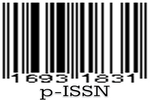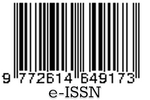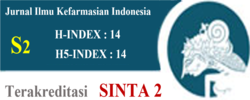Phytochemical profile, antioxidant activity, and sun protection potential of selected Annonaceae species
Abstract
Excessive sun exposure can damage the skin, highlighting the need for effective natural sunscreens. This study aimed to evaluate the phytochemical profile, antioxidant activity, total phenolic content (TPC), total flavonoid content (TFC), and sun protection factor (SPF) of five Annonaceae species. Methanolic leaf extracts of Annona muricata (soursop), Annona squamosa (sugar apple), Cananga odorata (cananga), Annona reticulata (nona), and Monoon longifolium (glodokan tiang) were analyzed. Phytochemical screening was performed to identify secondary metabolites. Antioxidant activity was determined using the DPPH radical scavenging assay, while TPC and TFC were measured spectrophotometrically. SPF values were calculated using the Mansur method. Phytochemical screening confirmed the presence of flavonoids, saponins, tannins, steroids, and phenolics in all extracts, with cananga leaves additionally containing alkaloids, coumarins, and essential oils. The DPPH assay showed antioxidant activity with IC₅₀ values ranging from 12.89–228.98 ppm, classified from very strong to weak. TPC and TFC values ranged from 12.33–31.75 mg GAE/g extract and 8.83–28.19 mg QE/g extract, respectively. SPF values ranged from 19.32–35.03, indicating all extracts fall under the ultra-protection category, with soursop leaf extract exhibiting the highest SPF. This study highlights the potential of Annonaceae leaf extracts, particularly A. muricata, as promising natural antioxidant and photoprotective agents due to their high polyphenolic and flavonoid content.
References
[2] M. I. Anik, N. Mahmud, A. A. Masud, M. I. Khan, M. N. Islam, S. Uddin, and M. K. Hossain, “Role of reactive oxygen species in aging and age-related diseases: a review,” ACS applied bio materials, vol. 5, no. 9, pp. 4028–4054, Aug. 2022.
[3] R. L. Arruda, N. O. de Sousa Garcia, N. F. Souza, F. M. da Silva, E. L. Arruda, and E. C. da Conceição, “Natural photoprotectors: a literature review,” research, society and development, vol. 10, no. 5, pp. e0810514603, Apr. 2021.
[4] P. A. Sampaio, E. C. Valena, F. S. Silva, J. R. da Silva Almeida, L. A. Rolim, X. P. Nunes, and E. C. da Cruz Araújo, “Flavonoids as photoprotective agents: a systematic review,” Journal of Medicinal Plants Research, vol. 10, no. 47, pp. 848–864, Dec. 2016.
[5] S. S. Chowdhury, A. M. Tareq, S. M. Tareq, S. Farhad, and M. A. Sayeed, “Screening of antidiabetic and antioxidant potential along with phytochemicals of Annona genus: a review,” Future Journal of Pharmaceutical Sciences, vol. 7, no. 1, p. 144, Jul. 2021.
[6] B. S. Al Kazman, J. E. Harnett, and J. R. Hanrahan, “Traditional uses, phytochemistry and pharmacological activities of annonaceae,” Molecules, vol. 27, no. 11, p. 3462, May 2022.
[7] A. O. Errayes, W. Abdussalam-Mohammed, and M. O. Darwish, “Review of phytochemical and medical applications of Annona muricata fruits,” Journal of Chemical Reviews, vol. 2, no. 1, pp. 70–79, 2020.
[8] M. Kumar et al., “Custard apple (Annona squamosa L.) leaves: nutritional composition, phytochemical profile, and health-promoting biological activities,” Biomolecules, vol. 11, no. 5, p. 614, Apr. 2021.
[9] N. Rahmawati, I. Y. Sholikhah, R. Mujahid, Y. Widiyastuti, A. E. Nugroho, and A. Rohman, “Ethnomedical uses of Cananga odorata (Lam.) Hook. F. and Thomson in indigenous traditional medicine among Indonesia ethnic groups,” Journal of Applied Pharmaceutical Science, vol. 14, no. 9, pp. 128–137, Sep. 2024.
[10] S. Nurmawati, “A phenetic study of the genus Monoon Miq. (Annonaceae) in Borneo, Indonesia,” in AIP Conference Proceedings, vol. 3048, no. 1, p. 020028, Apr. 2024, AIP Publishing LLC.
[11] R. Djamil and T. Anelia, “Penapisan fitokimia, uji BSLT, dan uji antioksidan Ekstrak Metanol beberapa spesies papilionaceae,” J. Ilmu Kefarmasian Indonesia, vol. 7, no. 2, pp. 65–71, Sep. 2009.
[12] R. A. Djamil. Octavia, “Determination of quality parameters and antioxidant activity of 70% ethanol extract of Nelumbo nucifera Gaertn. leaves,” Int. J. Appl. Pharm., pp. 30–33, Feb. 2021.
[13] C. Malsawmtluangi, D. K. Nath, I. Jamatia, E. Zarzoliana, and L. Pachuau, “Determination of sun protection factor (SPF) number of some aqueous herbal extracts,” J. Appl. Pharm. Sci., vol. 3, no. 9, pp. 150–151, Sep. 2013.
[14] D. K. Pratami, A. Mun’im, A. Sundowo, and M. Sahlan, “Phytochemical profile and antioxidant activity of propolis ethanolic extract from Tetragonula Bee,” Pharmacognosy Journal, vol. 10, no. 1, pp. 128–135, 2018.
[15] A. Shomali, S. Das, N. Arif, M. Sarraf, N. Zahra, V. Yadav, S. Aliniaeifard, D. K. Chauhan, and M. Hasanuzzaman, “Diverse physiological roles of flavonoids in plant environmental stress responses and tolerance,” Plants, vol. 11, no. 22, p. 3158, 2022.
[16] S. Sepahpour, J. Selamat, M. Y. A. Manap, A. Khatib, and A. F. A. Razis, “Comparative analysis of chemical composition, antioxidant activity and quantitative characterization of some phenolic compounds in selected herbs and spices in different solvent extraction systems,” Molecules, vol. 23, no. 2, p. 402, 2018.
[17] M. A. Ebrahimzadeh, R. Enayatifard, M. Khalili, M. Ghaffarloo, M. Saeedi, and J. Y. Charati, “Correlation between sun protection factor and antioxidant activity, phenol and flavonoid contents of some medicinal plants,” Iranian Journal of Pharmaceutical Research (IJPR), vol. 13, no. 3, pp. 1041–1047, 2014.
[18] R. Djamil, D. K. Pratami, and L. V. Riyantika, “Quality parameters test and α-glucosidase enzyme inhibitory activity of 70% ethanol extract of Keji Beling leaves (Sericocalyx crispus (L.) Bremek),” Jurnal Jamu Indonesia, vol. 5, no. 1, pp. 1–8, 2020.
[19] S. S. Setyotini, Sediarso, and W. L. Kharisma, “Analysis of heavy metal contamination in canned Ananas comosus Merr. fruit by atomic absorption spectrophotometry,” Jurnal Ilmu Kefarmasian Indonesia, vol. 4, no. 2, p. 92-95,2006.

This work is licensed under a Creative Commons Attribution-NonCommercial-ShareAlike 4.0 International License.
Licencing
All articles in Jurnal Ilmu Kefarmasian Indonesia are an open-access article, distributed under the terms of the Creative Commons Attribution-NonCommercial-ShareAlike 4.0 International License which permits unrestricted non-commercial used, distribution and reproduction in any medium.
This licence applies to Author(s) and Public Reader means that the users mays :
- SHARE:
copy and redistribute the article in any medium or format - ADAPT:
remix, transform, and build upon the article (eg.: to produce a new research work and, possibly, a new publication) - ALIKE:
If you remix, transform, or build upon the article, you must distribute your contributions under the same license as the original. - NO ADDITIONAL RESTRICTIONS:
You may not apply legal terms or technological measures that legally restrict others from doing anything the license permits.
It does however mean that when you use it you must:
- ATTRIBUTION: You must give appropriate credit to both the Author(s) and the journal, provide a link to the license, and indicate if changes were made. You may do so in any reasonable manner, but not in any way that suggests the licensor endorses you or your use.
You may not:
- NONCOMMERCIAL: You may not use the article for commercial purposes.
This work is licensed under a Creative Commons Attribution-NonCommercial-ShareAlike 4.0 International License.




 Tools
Tools





















